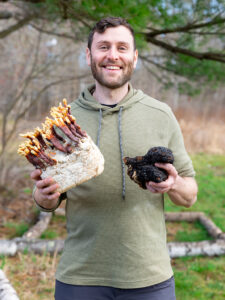
Louis Giller: Mushrooms can detoxify our land
Every Month PelotonLabs founder Liz Trice interviews a community member for The West End News. This month Liz caught up with Louis Giller, Customer Service Specialist and Educator at North Spore, which sells materials for growing culinary mushrooms.
I know North Spore sells kits for growing mushrooms for food. But what really interests me is how mushrooms can detoxify our land.

When we use mushrooms for detoxification, we call it mycoremediation. Years ago, I read “Mycelium Running” by Paul Stamets, how they can help save the world, break down toxins, remove heavy metals, and it blew my mind! I was living in Colorado and got a grant to study using mushrooms to remove heavy metals from straw that had been soaked in the gnarly mine effluent. Oyster mushrooms have been shown to be able to break down disposable diapers, cigarettes, and even plastics into food grade mushrooms. That’s amazing!
When there’s a single point source polluter you can sometimes create biofilters – mycofiltration – using straw colonized by oyster mushrooms or other fungal mycelium. The Massachusetts Department of Transportation has a project using fungi alongside roads to reduce runoff damage. PACT, a company in California, sells little tablets of myceliated substrate you can drop into a cathole you poop in while camping.
How can we use mushrooms to address toxins in soil and water in Maine?
It’s easiest when a pollutant source like PFAS or toxins from mines or paper mills can be identified and contained. It’s harder once it’s spread through a large area. Even though mycoremediation was shown to work twenty-five years ago, it will require a lot of investment into research and development and testing for there to be regular commercial applications that industry and the EPA will adopt.
One guy in North Carolina was working with the “train wrecker” mushroom that can break down the creosote in rail ties, which normally resist degradation. Mycocycle, is working to scale mycoremediation to break down petroleum-based materials like asphalt. Oil is essentially made of ancient living things – it’s organic – and mushrooms can break it down into carbohydrates. The oyster mushroom genus, Pleurotus, can break down almost anything. Sometimes the mushrooms can actually break down the toxins into something benign, other times mushrooms can pull out toxins, then you have to dispose of the mushrooms.
A number of universities are working on mycoremediation, but one challenge is that federal regulations require the removal of most of the targeted contaminants within a short time frame. Many mycoremediation solutions work too slowly or are too difficult to implement to be embraced on an industrial scale. “Radical Mycology” by Peter McCoy is an amazing book covering all things fungi and it spends considerable time on mycormediation. In fact, McCoy is directly involved with Mycocycle.
So what are you doing at NorthSpore?
At NorthSpore, we’ve just reached the point where we’re a stable, mature company, and can start to put more resources into R&D. Right now, we are doing multiple experiments! I’m involved in one regarding different ways of growing chicken of the woods and hen of the woods (maitake) mushrooms. We also have a research partners program as well as a scholarship. We’re positioned well to help with many different types of applied mycology. So nobody should hesitate to reach out if they have ideas!
What do you want everyone to know about mushrooms?
Maine is the most forested state in the union, and that means we have great areas to look for wild mushrooms. I want to encourage everyone to get out into the woods and start to understand how abundant mushrooms are in Maine. We also have great opportunities to grow mushrooms through log inoculations. Shiitake has been grown for thousands of years in China and Japan and growing them on logs is so cool.
So how can someone start growing mushrooms for food?
Anyone can grow mushrooms incredibly fast indoors as a beautiful and gourmet protein source. Buy a spray and grow kit. They’re only about $30. It’s a colonized block of sawdust, you put it out of the sun on your counter or dresser, spray it to keep it moist, and you’re pretty much guaranteed one to two pounds of oyster or lions mane mushroom. Wine caps are really easy to get going in your garden beds. Even without having a green thumb, you can have a “moldy thumb.”
Also, how can one start foraging for wild mushrooms?
We sell a great book by David Spahr, “Edible and Medicinal Mushrooms of New England & Eastern Canada.” It’s a beginner foraging book with great pictures. Then get a good knife and learn where to look. But mushrooms come up everywhere, and no mushroom can hurt you by touching it. So, get in there close and examine them. It will blow your mind!
A magnifying glass can be fun, and if you get a flashlight with a UV setting you can see mushrooms that react and glow green in the UV light. You don’t even need to know what type they are, it’s just cool.
Remember, it’s a whole kingdom of life, just like plants and animals.
Links
NorthSpore Growing Kits, Books, and other tools
Mycoremediation Examples & Science
Removal of Fecal Coliform Bacteria
Mycoremediation Updates Overview 2023
Mycoremediation Design Courses
North American Mycological Society
Mycoremediation Design Course, Oregon July 17-23
Mushroom Mountain – These guys are a very trusted source for information of many types. In fact, the former owner, Tradd Cotter, wrote a great book called “Organic Mushroom Farming and Mycoremediation.” Find it here.
Local Events & Classes
Mycology Outside Weekend in September at the Ecology School in Saco





